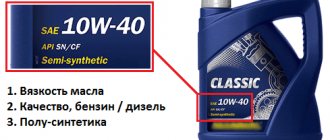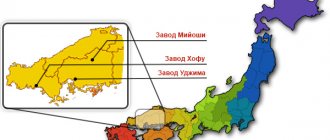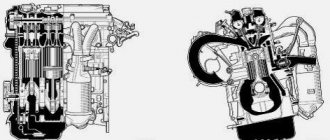Just a few years ago, the word “Mazda” evoked in many fans of the brand the same stingy emotions as, for example, a television match between two chess players. Mazda models were family cars that were assembled in Hiroshima. They did not impress with their appearance (with the possible exception of the Xedos model) and driving performance. And yet, Mazda was famous for its reliability and durability. The only thing that caused negative emotions was the poor protection against corrosion.
In the end, the Japanese decided to get rid of their boring cliches, and in 2002 the world saw the stylistically attractive “six”, and a year later it was joined by the no less charming “troika”. Since then, Mazda marketers have insisted that their cars embody passion, dynamism and sporting spirit. Yes, it’s hard to disagree with this. It’s a pity that the changes have been achieved at the expense of durability: the “six” of the GH series (2007-2012) can only dream of the reliability of former Mazda models.
The second-generation “Six” uses many modern technological advances, which subsequently brought a lot of trouble to owners, especially in copies of the initial production period. For example, DPF filters, electrics, rear lights with LED technology. To this should be added the old scourge - corrosion.
Yes, it's hard to believe, but the Mazda 6 Series GH can rust! And in the same places as its predecessor. When inspecting the car, be sure to check the condition of the rear wheel arches, hood and lower edges of the doors. Cars produced in 2008-2009 required additional anti-corrosion treatment of internal cavities. In station wagons, water sometimes got onto the ceiling lining through the points at which the roof rails were attached to the roof.
Considering the disadvantages described above, the high price for used copies is a little surprising. However, demand for the Mazda 6 GH Series is strong, perhaps due to the good reputation of its predecessor. For the version with a 1.8-liter gasoline engine with 120 hp. you will have to pay at least 450,000 rubles, while the diesel version with a 2-liter 140-horsepower unit is almost 100,000 rubles more expensive. The prices for maintenance and spare parts at dealer services are somewhat puzzling - they are so high, as if Mazda belongs to the premium segment. Cheap analogues save the day. The range of substitutes is slowly but surely expanding.
Fortunately, the Mazda 6 has many advantages. The exterior and interior design deserve special compliments. The GH six seems much larger than its predecessor, which is really noticeable in the second row. The equipment, compared to the first generation, has become richer. The hatchback trunk has a capacity of 510 liters, while the sedan and station wagon have a capacity of 519 liters. This is a good result for a middle class car. Another plus is the ingenious folding system for the rear sofa.
Flaws? The quality of the plastic used in the interior does not fit with the high price of the “six”. By 100-150 thousand km, scuffs appear on the steering wheel and automatic lever.
Many drivers complained about seat squeaking. As part of the warranty repair, official services placed additional soundproofing material between the chair frame and the cushion filling. Over time, play also appears due to wear of the attachment points or a burst bracket.
Chassis
The tight suspension of 2007-2010 models provokes a dynamic driving style, but the “rubber” steering prevents you from having fun. After 2010, the chassis settings changed a little. And yet, the Mazda 6 behaves confidently and stably.
In general, the Mazda 6 suspension endures hardships and hardships while traveling on Russian roads: its components easily reach 100,000 km. But then it will take quite a lot of money to rebuild it. For example, an original front lever costs almost 20,000 rubles. Analogues are half the price - about 9,000 rubles. “Consumables” are struts, stabilizer bushings and steering ends, which traditionally have to be changed more often. The rear suspension is a slightly modified design of its predecessor - it is durable, simple and inexpensive to repair.
After 80-100 thousand km, the front wheel bearings may need to be replaced. The cost of the original is 3,000 rubles, the analogue is 2,000 rubles. And after 150,000 km, the right inner CV joint or one of the outer ones may require replacement. The cost of internal is 15,000 rubles for the original and 5,000 rubles for an analogue, external - 25,000 rubles and 5,000 rubles, respectively.
Closer to 80-100 thousand km, problems with the steering rack are common, and sometimes the power steering also fails. Knocks, clicks, vibrations and excessive effort appear when turning the steering wheel in one direction. Repairing the rack will cost 15,000 rubles.
Mazda 6 did not get rid of the disease of its predecessor - souring of the rear calipers. The disease manifests itself after 120-150 thousand km. The cost of the repair kit is about 1,000 rubles.
The optional tire pressure monitoring system (TPMS) also causes minor inconvenience. In addition to losing connection between the sensors and the car, it can gradually leak air from one of the wheels. If you're lucky, you'll be able to find new valves outside of dealerships, but they are still expensive - about 2500-3000 rubles apiece.
Mazda 6 what engine
Discussion of issues related to the first generation car...
- Reply with a quote
What engine?
edikoz Thu, 24 Nov 2011, 10:30
- Reply with a quote
Re: What engine?
Wodilich Thu, 24 Nov 2011, 10:32
Wodilich Veteran of the movement Messages: 5652 Thanks: 179 pcs. —> Thanks: 179 pcs. Registration: Fri, 04 Nov 2011 From: From there Car: Airbus A380-800
- Website
- Reply with a quote
Re: What engine?
edikoz Thu, 24 Nov 2011, 10:40
- Reply with a quote
Re: What engine?
Larry Thu, 24 Nov 2011, 10:45
Larry Moderator (74) Messages: 7600 Thanks: 93 pcs. —> Thanks: 93 pcs. Registration: Tue, June 30, 2009 From: Chelyabinsk Car: M6 2.0AT 2016
- ICQ
- Reply with a quote
Re: What engine?
edikoz Thu, 24 Nov 2011, 10:52
- Reply with a quote
Re: What engine?
Wodilich Thu, 24 Nov 2011, 11:04
Wodilich Veteran of the movement Messages: 5652 Thanks: 179 pcs. —> Thanks: 179 pcs. Registration: Fri, 04 Nov 2011 From: From there Car: Airbus A380-800
- Website
- Reply with a quote
Re: What engine?
Ninja Thu, 24 Nov 2011, 12:50
Ninja Flood Maniac Messages: 17644 Thanks: 758 pcs. —> Thanks: 758 pcs. Registration: Thu, 16 Aug 2007
- Reply with a quote
Re: What engine?
edikoz Thu, 24 Nov 2011, 18:53
- Reply with a quote
Re: What engine?
C2H5OH Mon, 28 Nov 2011, 00:15
C2H5OH Joined the movement Messages: 67 Thanks: 2 pcs. —> Thanks: 2 pcs. Registration: Fri, 10 Jun 2011 From: Krasnoarmeysk M.O. Car: M6/2.0/automatic/2004
- ICQ
Some gasoline engines that were installed on various generations of Mazda 6 models have become more popular than other powertrains. For example, the MZR L813 engine, which can be seen in both the first and second generations, as well as in additional restyling.
A little about the technical characteristics of the MZR L813. Its exact displacement was 1798 cm3, and its maximum power was within 120 hp. 4 cylinders arranged in one row, 16 valves. Fuel consumption in the city is no more than 8.3 - 8.5 liters, on the highway - 6.9 - 7.0 liters. The most acceptable unit with fairly economical fuel consumption, provided that its octane number is at least 95.
Also, from the first generation, the Mazda 6 model was equipped with an MZR LF17 gasoline engine, with a displacement increased to two liters (more precisely - 1999). With such characteristics, its consumption has become even less than that of the MZR L813 unit (in the city - 8.8 liters, on the highway - 6.6 liters). The same number and arrangement of cylinders and valves. For maximum productivity, you must use fuel with an octane rating of at least 95.
Electrics
Electrics of the Mazda 6 are not one of the strengths of the “six”. Most often, malfunctions occur in the central locking system and the factory audio system head unit. The bulk wire corrodes quite quickly, which makes it difficult to successfully start the engine. In addition, many owners complain about quickly burning out external lighting lamps, including LED rear lights. For your information, the headlights use rare H9 and P11 lamps.
Simultaneous disabling of ABS, DSC and dynamic stabilization system is associated with loss of communication between the controller and one of the ABS sensors. There are several reasons. Most often, a lot of dirt collects on the magnetic tape of the wheel bearing. But there may be problems with both the contacts and the wiring of the sensors. Less often you have to change the sensors themselves or the wheel bearing (due to tape wear).
In cars produced in 2008, a problem with the trunk lock is quite common: it lives its own life, independently deciding when it is necessary to open the lid. It's all about the leaky button, where moisture gets in, closing the contacts. Afterwards the button was improved, and the disease was practically cured. However, similar symptoms also occur when the wiring inside the protective corrugation between the trunk lid and the body breaks.
Mazda 6 2.0 engine design
Motor Skyactive Mazda 6 is not just a beautiful marketing ploy, but also serious design work. The Japanese decided to apply all the best in engine building in one unit. The in-line 4-cylinder, 16 valve engine has an aluminum cylinder block and aluminum cylinder head, direct fuel injection, variable valve timing system, and a timing chain drive. Hydraulic compensators are also installed in the block head.
The Mazda power unit received a unique intake and exhaust system. In particular, the creators of the two-liter SkyActiv-G used extended 4-2-1 exhaust manifolds (the so-called spider) so that exhaust gases were removed from the combustion chamber as freely as possible without interfering with mixture formation.
But the most noticeable feature of this engine is the compression ratio, which is increased to an incredible 14:1!!! For example, for a regular gasoline engine this figure is around 10. The connecting rod and crank mechanism is as lightweight as possible. Plus the pistons are of a completely unusual shape. You can compare in the following image.
Mazda 6 2.0 engine cylinder head
Mazda 6 cylinder head
made of aluminum alloy and has a rather complex structure. Hydraulic compensators are designed to minimize human intervention in the valve mechanism. The dual variable valve timing system has hydraulic phase shifters on the camshaft sprockets as actuators.
Timing drive of Mazda 6 2 liter engine.
As we already wrote above, the gas distribution mechanism drive itself has a chain drive. Most modern 16 valve DOHC engines, both belt and chain driven, have a common serious problem. If the belt breaks, the chain stretches, or the valve teeth are sheared, the valves collide with the cylinders, causing serious engine damage. By the way, in addition to the timing chain, the engine contains another small chain that transmits torque from the camshaft sprocket to the oil pump sprocket.
Mazda 6 2 liter engine characteristics
- Working volume – 1997 cm3
- Number of cylinders – 4
- Number of valves – 16
- Cylinder diameter – 83.5 mm
- Piston stroke – 91.2 mm
- Timing drive - chain
- HP power (kW) – 150 (110) at 6000 rpm. per minute
- Torque – 210 Nm at 4000 rpm. per minute
- Maximum speed – 207 km/h
- Acceleration to the first hundred – 10.5 seconds
- Fuel type – gasoline AI-95
- Fuel consumption in the city – 8.3 liters
- Fuel consumption in the combined cycle – 6.1 liters
- Fuel consumption on the highway – 4.9 liters
The Skyactive engine from the Japanese manufacturer will delight you with excellent power with minimal fuel consumption. In our market, the engine is combined only with a 6-speed automatic transmission.
The expected modification in the form of a “boring” for the pistons, which makes it possible to avoid their bending when the timing belt breaks, was never implemented on the 1.8-liter engine in the VAZ-21179.
Instead, it was made on the more popular 1.6-liter engine, already installed on both the Granta and Lada Vesta models.
The first photographs of “stickless” pistons installed on Lada cars, intended for a 1.6-liter engine, as well as similar products in the process of being finalized for a 1.8-liter engine, were published on the Lada.online Internet portal.
The difference in these two pistons is the presence of shallow grooves on the model for the 1.8 engine, and deeper machined grooves on the 1.6. The need to create recesses at 1.8 is due to the possibility of preventing the piston from hitting the valve during the operating cycle. If the timing belt breaks, the valves move down. If the excavation is not deep enough, deformation occurs. The production of valves is carried out by Federal Mogul, whose plant is located in the city of Tolyatti.
The older “sixth” model in Mazda’s passenger car series is the most popular, thanks to its aggressive design, refined handling and decent equipment. The current generation of Mazda 6 distinguishes itself with high quality, dynamics and comfort. Unlike its predecessors, Mazda's new high-tech engine has more power with less displacement, but is renowned for its same reliability.
Engines
Nothing bad can be said about gasoline power units. Moreover, regardless of the engine option, you can fully count on exemplary reliability. In all gasoline engines, Japanese engineers used a timing chain drive that does not require maintenance. Common problems include wear on the right engine mount (mount) and failure of the oxygen sensor (lambda probe) - after 100-150 thousand km. In the first case, vibration will appear, to eliminate which you will have to spend 5-8 thousand rubles. In the second case, the “check” light will light up, interruptions in engine operation will occur, traction will drop or fuel consumption will increase. The original probe will cost 13,000 rubles, an analogue - 5,000 rubles.
The base 1.8-liter engine is too weak, and the 2.5-liter 170 hp is quite thirsty for its performance - more than 12 l/100 km.
The golden mean is a 2-liter engine: it is quite economical (9-10 l/100 km) and dynamic (0-100 km/h in 10 seconds). Unfortunately, after 100,000 km, the dampers in the intake manifold may begin to knock. It's all about the wear of the damper drive lever, made of plastic. The cost of a new part is about 2,000 rubles.
But what was said above about gasoline units does not apply to diesel modifications of the Mazda 6. Particular care should be taken when approaching a diesel engine with a displacement of 2 liters (2.0 MZR-CD). The risk of costly repairs is too high, especially for cars from 2007-2010. Most of the problems are caused by the DPF filter. With frequent short trips or city use, the engine oil level increases excessively. This occurs due to diesel fuel getting into the oil during the burning of the DPF filter. As a result, oil can get into the intake, which is dangerous due to “the engine going into overdrive” (an uncontrolled increase in speed). But this is rather an exception to the rule. What is much more serious is that diesel fuel, when it gets into the oil, dilutes it, the lubricating properties deteriorate, and the wear of rubbing parts accelerates. In 2008, the software was changed, thanks to which the alarm indicates in advance that the critical oil level has been exceeded, which, in turn, reduces the risk of problems.
There are known cases of intercooler rupture - a loud whistle appears and engine power drops. In addition, mechanics pay attention to problems with the oil pump. It is driven by a gear located on the crankshaft. Gear teeth wear out quite quickly - after 60,000 km.
Often, wear products clog the oil intake in the engine crankcase, which can ultimately lead to engine seizure. During the restoration process, the crankshaft will need to be replaced, which is very expensive - about 80,000 rubles. The cause of the problem is not only a design flaw, but also the manufacturer’s overestimated oil change interval. How to deal with this? Change the oil as often as possible, at least once every 8,000 km. And after every 3-4 replacements, remove the pan and clean the oil intake. Mechanics are confident that this will significantly extend the life of the motor.
Another point is that Denso injectors cannot be restored. And the cost of new ones is prohibitively high - 19,000 rubles apiece. And, nevertheless, the reliability of Denso injectors is considered acceptable, but with washers everything is not so good. They need to be changed regularly. Problems with the injectors will be indicated by uneven engine operation, which is not uncommon for this model. Complaints about floating speeds and jerks during acceleration are not isolated cases.
The timing drive of the 2-liter diesel engine is of the belt type. As a rule, problems with the timing belt do not arise, but it is better to prudently change the belt every 90,000 - 100,000 km.
A variable geometry turbocharger is quite reliable, but in case of repair it will require large expenses. Due to the “weakness” of the engine at the bottom, the clutch and flywheel are not consumable components.
For daily use, a more reliable 2.2-liter turbodiesel with a power of 185 hp is much better suited, but Mazda 6 with such a unit are more expensive, at least 50-100 thousand rubles. It is important to note that the Japanese used a completely different DPF filter here, with which there are no problems, unlike the 2.0 liter diesel engine. The only thing you should know is about problems with the timing drive: there are cases of stretching of the camshaft drive chain - extraneous noise appears. Please note: good dynamics are provided by diesel modifications with power from 163 hp.
Gasoline engines
Great news: all gasoline engines have proven themselves very well. They have four valves per cylinder and a timing chain that almost never fails. Leaks of liquids and oils are observed extremely rarely, and even then only in cars with mileage significantly exceeding 200,000 km. At the same time, engines are intolerant of cheap and “old” oil - the piston rings wear out quickly.
Engines with a displacement of 1.8 and 2.0 liters are very similar in design and differ little in their characteristics. They do not have direct injection, and therefore are suitable for installing gas equipment. The 2.3-liter engine with variable valve timing creates a little more problems. It consumes a lot of oil, and therefore requires constant monitoring of its level. The six-cylinder units were intended for the US market, and the turbo engines were intended for the top versions of the MPS with all-wheel drive.
The two-liter petrol engine is reliable and economical.
Transmission
Mazda 6 owners often complain about the manual transmission - problems arise with shifting. The synchronizers are to blame for this. The clutch service life is about 150-200 thousand km. The cost of a new set is around 5,000 rubles. Despite the absence of an official recommendation for changing transmission oil in a manual transmission, all mechanics unanimously advise doing this no later than 100,000 km. Much more often an automatic transmission needs an oil change - every 60,000 km.
By 80-100 thousand km, many Mazda 6 owners with automatic transmission note the appearance of kicks when moving from 3rd to 4th. The reason is the development inside the box body. For repairs you will need about 40,000 rubles. After 100-150 thousand km, another danger awaits the owners - coolant getting into the box, which leads to loosening of the clutches. The reason is the destruction of the heat exchanger fitting. The radiator will have to be completely replaced, paying 15,000 rubles for the original or 10,000 rubles for a high-quality analogue.
Diesel engines
The most common Mazda 6 diesel engine is the two-liter CiTD turbodiesel (MZR-CD), which develops 140 hp in the latest version. The engine has a unique design: with four valves per cylinder, there is only one camshaft in the head. Typically, with this number of valves, two shafts are used for intake and exhaust. As a result, the camshaft experiences increased loads. Therefore, it is important to use lubricants recommended by the manufacturer. The Mazda 6 diesel is equipped with a common rail injection system, a DPF particulate filter and a timing belt drive.
Like others, Mazda diesel engines had their drawbacks.
At first, the air intercooler often failed. The recirculation valve and the injection pump dosing valve were jammed. The problem was fixed on vehicles produced in 2006.
The particulate filter also created problems. During operation, diesel fuel entered the engine lubrication system. The oil change interval in urban conditions was reduced by 2-3 times.
Troubles can be avoided with timely maintenance using branded oils and spare parts. Otherwise, there is a high probability of the motor jamming. Repairing a diesel engine costs a pretty penny. It's easier to buy a contract engine.
An additional advantage of the diesel version of the Mazda 6 was the presence of an autonomous Webasto heater, which facilitates engine starting at low temperatures. The new generation Mazda Skyactiv-D 2.2 diesel engine has become more economical and lighter than the previous engine. The Skyactiv-D compression ratio is unusually low for diesel engines - 14:1. Starting a diesel engine in cold weather is ensured by special electronically controlled systems. The engine produces a peak power of 150 hp. at 4500 rpm and provides enviable elasticity.
Mazda 6: description, engines, automatic transmission, technical specifications
Mazda 6 is a mid-size Japanese car from the manufacturer Mazda Motor Corporation. In the Japanese and Chinese markets the car is sold under the name Mazda Atenza. The year the car production began was 2002. 3 generations of Mazda 6 were manufactured. The 1st generation is still manufactured in China. The model has a characteristic set of body types for cars of its class - sedan, station wagon and hatchback. Since 2013, the assembly of 3rd generation sedans for the Russian market has been carried out in Vladivostok.
Engine Ford Duratec-HE 1.8 l
The Ford Duratec-HE/MZR L8 power unit is also called the Mazda MZR L8 and was created by the Japanese as an evolution of the Mazda “F” series of engines. Previously, Ford installed the Duratec-HE/MZR L8 on the Mondeo model, but later the engine was improved, an intake manifold channel control system, a direct ignition system, electronic throttle valves, etc. were installed. The 1.8-liter Duratec now features a timing chain drive, which increases its reliability. Read more about Ford Duratec-HE 1.8 l engine…
Engine SkyActiv-G 2.5
The Mazda SkyActive 2.5 engine is installed on Mazda 6 and Mazda CX-5 cars. The engine appeared along with the two-liter version of SkyActive 2.0. The engine replaced the old Ford MZR series engines of the L model with a volume of 2.3 and 2.5 liters. Like all engines in this series, the motor is very modern. High compression ratio 14:1, Dual S-VT variable phase system, 4-2-1 exhaust manifold (spider), direct fuel injection, specially shaped pistons that ensure optimal fuel combustion throughout the entire stroke, hydraulic compensators. Read more aboutSkyActiv-G 2.5 engine…
Engine SkyActiv-G 2.0
The Mazda SkyActiv-G 2.0 engine is designed for installation in Mazda 3, Mazda 6 and Mazda CX-5 cars. The engine has been produced since 2011. The engine was designed to replace the Ford 2.0 liter engine (index MZR LF). The SkyActiv 2.0 engine features the same range of innovative technologies as the SkyActiv 1.5 engine. There is a Dual S-VT variable valve timing system on two camshafts, an exhaust manifold that provides the effect of dynamic purging of exhaust gases in the combustion chambers due to the optimal length and 4-2-1 configuration. Read more aboutSkyActiv-G 2.0 engine…
Engine Duratec HE 2.0/MZR LF
The design of the Duratec HE/MZR LF 2.0L engine is largely the same as the 1.8-liter version, but the cylinder diameter is already 87.5 mm. The MZR series engine was developed by Mazda engineers for the LF models, and Ford used it as part of the collaboration. If we compare the 2.0-liter version with the 1.8-liter, the larger-volume engine is better in all respects. It works more powerfully, but quietly and smoothly, there are no floating speeds. The timing chain drive increases the reliability of the unit, the service life of which is designed for 350,000 kilometers. Read more about Duratec HE 2.0/MZR LF engine…
Source
Reviews from car owners
When constantly using a car in urban conditions, it is best to change the engine oil after 7-8 thousand kilometers. Mazda 6 power units can be tuned. You can install a turbine on the SKYACTIV modification, but you will have to redo the connecting rod and piston group, which will negatively affect all the advantages and features of this version of the car. Many owners carry out chip tuning of the Mazda 6 engine by removing the catalyst and flashing the control unit. But in most cases, it is only possible to increase the power of the car, while the actual resource remains unchanged. I will tell you in detail about the real service life of Mazda 6 engines from the owners' reviews.
Engine 1.8
The Mazda 6 version with a 1.8-liter power unit is capable of traveling 350,000 kilometers or more. All engine modifications in all three generations are reliable. The SKYACTIV version has won prizes in the “Best Engine” category almost every time since 2012. The owners speak positively about this power unit, highlighting its strength – a large resource.
Engine 2.0
The modification with a 2-liter engine is distinguished by the high reliability of the power unit. The main problems with Mazda 6 for owners arise after the first 200,000 kilometers, in particular, problems with the steering rack have been noticed. The engine remains in good condition. Increased oil and fuel consumption is observed in extremely rare cases. Many Mazda 6 owners drive their car for more than 350 thousand km, which is higher than the rated service life.
Source











